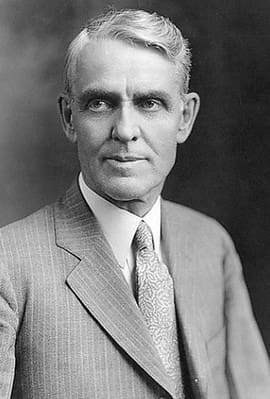By Ron Wilson, director of the Huck Boyd National Institute for Rural Development at Kansas State University
Four statues stand in the rotunda of the Kansas statehouse. Three of those statues honor persons whose names are widely known: Aviatrix Amelia Earhart, President Dwight D. Eisenhower, and publisher William Allen White.
Who is the fourth? Arthur Capper, a man from rural Kansas.
In his day, he was a titan of publishing, politics, and philanthropy – and he cared especially for 4-H youth and children with disabilities. Thanks to the Kansas Historical Society and the Capper Foundation websites, which are sources for this information.
Arthur Capper was born in 1865 in Garnett, Kansas. At the time, Garnett was a rural community of 1,219 people. Now, that’s rural
Capper’s father was an abolitionist and his mother was a Quaker. At the age of 14, young Arthur became a “printer’s devil” with the Garnett Journal. After graduation from high school, Capper went to work as a typesetter for the Topeka Daily Capital. Working his way up at the newspaper, he became an editor and served as correspondent covering the state legislature and U.S. Congress.
In 1892, Capper married Florence Crawford, daughter of Governor Samuel Crawford. Florence, by the way, is the person for whom the town of Florence, Kansas, was named. He moved up through the journalism ranks to become a newspaper publisher and owner of newspapers and a radio station.
In 1908, a special celebration was conducted for Capper’s birthday. It grew into an annual celebration called Children’s Day, including a free carnival, pony rides, games, ice cream and other refreshments. Nearly 20,000 people attended the event. It was held annually until Capper died in 1951.
In 1909, Capper was named chairman of the Board of Regents of what would become Kansas State University. In 1912, Capper ran for Governor. It was the year that the Republican party split between the old guard and the Bull Moose party of Teddy Roosevelt. Capper lost that election by 29 votes. It was the only time he ever lost a campaign for elective office.
Two years later, Capper ran for Governor again and won. He was the first native-born Kansan to be elected Kansas Governor. He served two terms and then ran for the U. S. Senate.Capper served five terms as U.S. senator, from 1919 to 1949. He chaired the Senate agriculture and forestry committee during the 89th Congress.
He was the lead sponsor of the Capper-Volstead Act which led to the creation and growth of farmer-owned cooperatives. The Arthur Capper Cooperative Center in K-State’s department of Agricultural Economics bears his name.
Capper Publishing grew to become the largest publishing house west of the Mississippi. It had one weekly, two daily and five state farm newspapers as well as two national magazines. Capper’s Weekly was a staple in farm homes all across the Midwest.
Capper became one of the nation’s leading publishers of the decade. In 1926, he was featured on the cover of Time magazine.
Capper established agricultural clubs that loaned money to students to start businesses. These clubs eventually merged into the 4-H movement. Capper was named to the national 4-H hall of fame.
In addition to being an advocate of agriculture, he was an advocate of child welfare. He organized the Goodfellows Club of Topeka, a group of men who gave candy and toys to kids on Christmas. When he realized that some kids were unable to come outside and receive these gifts because of diseases such as polio, he started to raise funds for the benefit of those children.
That was the beginning of the Capper Foundation. Today, the Foundation provides individualized care and needed therapies to infants, children, teens and adults as well as their families from 46 cities across Kansas.
Arthur Capper served in the Senate until he chose not to run for re-election. He was in the Senate for 30 years, making him our state’s longest-serving Senator in history.
It is fitting that Arthur Capper is one of the four statues that stand in the Kansas Capitol rotunda today. He was an amazing Kansan whose legacy continues to make a difference, especially in the lives of special Kansas children and families.
Audio and text files of Kansas Profiles are available at https://www.huckboydinstitute.org/kansas-profiles. For more information about the Huck Boyd Institute, interested persons can visit http://www.huckboydinstitute.org.













